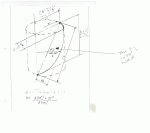I need help trying to figure out the radius of a line that travels at an agle around a cylinder. (this is for some spiral stairways, I need to know what roll radius to give our fabricator)
Some one gave me this formula, but I'm not 100% sure it's correct
c=hypotenuse a=width b=height
r=radius of lenght traveled (this is what I need)
VS=is the distance between the midpoint of my arc and the midpoint of "a"
c=sq root of (a^2=b^2)
r= (4(VS^2)+c^2) / 8(VS)
Thanks in advance.
I have a picture of what I need i can e-mial it if you need clarification.
Some one gave me this formula, but I'm not 100% sure it's correct
c=hypotenuse a=width b=height
r=radius of lenght traveled (this is what I need)
VS=is the distance between the midpoint of my arc and the midpoint of "a"
c=sq root of (a^2=b^2)
r= (4(VS^2)+c^2) / 8(VS)
Thanks in advance.
I have a picture of what I need i can e-mial it if you need clarification.


